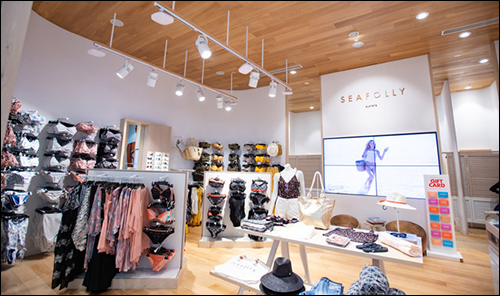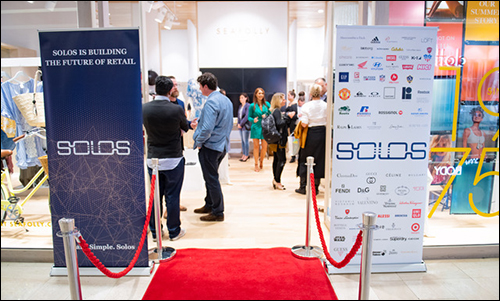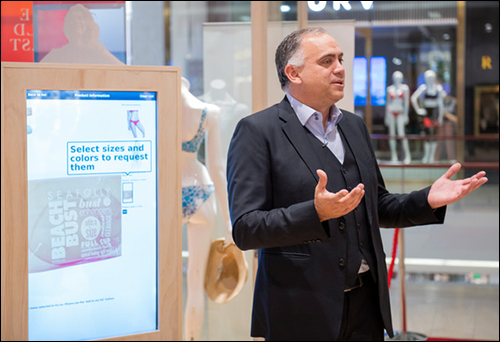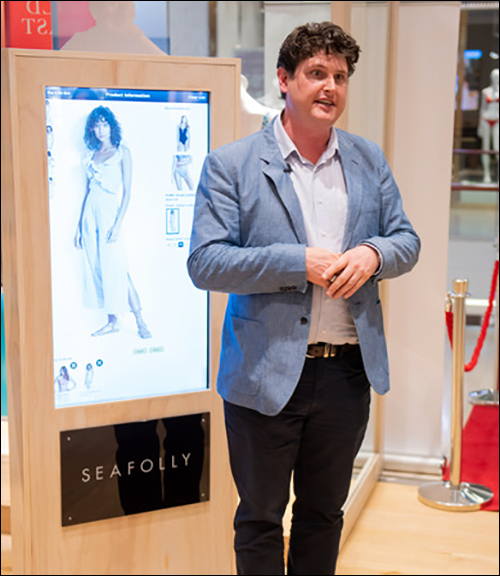Following a three-month pilot of radio frequency identification technology to automatically track inventory and provide personalized content in fitting rooms, Australian swimwear brand Seafolly is considering deploying the technology across 71 stores worldwide, beginning in March of this year. Assuming the deployment proceeds, it is scheduled to be completed in November. Initially, the deployment of RFID readers and cloud-based software to manage read data will be dedicated to inventory tracking, while fitting room technology could follow.
The passive UHF RFID system, including overhead readers and magic mirrors, is supplied by Solos. The system employs smart mirrors from Keonn Technologies, along with software provided by Riot Insight to manage the collected read data.
Solos also provides its cloud-based Solos Sensor Platform software, integrated with enterprise resource planning (ERP) software, to manage read data and prompt replenishment orders. Seafolly sells swimsuits, beachwear and accessories for women and girls. The Australian brand and retailer operates stores in its own country, as well as in the United States and Singapore, and produces more than 2 million articles of clothing annually.
Traditionally, the company has utilized a bar-code scanning method to conduct manual stock counts. The process was time-consuming, however, and provided only about 80 to 85 percent accuracy, the firm indicated to Solos. It sought to reach close to 100 percent accuracy, so in July 2018, the company began working with Solos to develop a solution for in-store tracking. At that time, says George Monemvasitis, Solos’s CEO, the technology firm met with Paul Kotbra, Seafolly’s CEO. (Seafolly was unavailable to comment for this story.)

“Considering our RFID technology was a first in the Australian retail market,” Monemvasitis says, “we offered the company a 90-day pilot to demonstrate our claims of 98 to 99 percent inventory accuracy.” The pilot also proved that the software could be integrated with the company’s ERP and point-of-sale (POS) software, and thereby eliminate the need for manual stock-counting.
The pilot took place at the Westfield Bondi Junction Seafolly store, located in Sydney, Australia. The installation (which is still live) consists of 13 fixed RFID readers, with built-in Intel reader modules installed in the store’s front ceiling, along with three in the back room. “We also provided the store with a secondary check-hand scanner,” Monemvasitis says, which was provided by Zebra Technologies. In addition, Zebra supplied a printer to create labels in the store.
The system includes magic mirrors installed in fitting rooms, each with a built-in RFID reader. When a customer enters a fitting room, the reader in the mirror detects the unique ID number on the garment label, then displays content related to that item (such as color and size options), along with other style recommendations (such as accessories or other garments with which it could be paired).

The screen provides concierge services as well. The software includes a function by which a user can tap on the mirror, which serves as a touch screen. If he or she selects a new size or item-request prompt, an alert is forwarded to an employee so that the garment can be brought to the customer in the fitting room.
During the pilot, as goods were received at the store, staff members used a bar-code scanner and an RFID printer (provided by Solos) to create a tag. Workers simply scanned each product’s bar code. Solos’s cloud-based software received the item’s stock-keeping unit (SKU) data and linked it to the unique ID number encoded on the tag in a printer. The printer then produced that tag, which could be applied to the price label.
As the item was stored in the back room or moved onto the sales floor, the software captured the zone in which its tag was being interrogated, based on the specific reader, and updated that location. Sales personnel could then view data in the software to learn where a specific item was located, as well as conduct inventory counts and ensure that products had not been misplaced in the wrong zone—for instance, a child’s suit being moved to the adult section.
For the full deployment, the company reports, the technology will be used in the same way. The handheld reader is being employed to offer redundancy, in order to ensure that inventory counts remain accurate. The device captures tag reads and forwards the collected data, via a Bluetooth connection, to a mobile device such as a smartphone, which can then access the Solos software.
During the pilot, Solos reports, Seafolly found that inventory accuracy was between 98 and 100 percent. This increase in accuracy is expected to boost sales by preventing out-of-stocks. It also enables omnichannel sales, due to the company having more accurate inventory counts, since customers can now place orders and pick up products at the nearest store, based on that store’s inventory data. The firm also expects to save the labor cost of employing staff members to manually conduct stock counts.
The installation at one store took approximately two days to complete, Solos reports. While tags were applied to products in the store during the pilot, the full-scale rollout is expected to include transitioning to all products being tagged at the point of manufacture. When this happens, Solos’s Sensor Platform software will enable management to track the movements of ordered products throughout the entire supply chain. “Solos has enabled us to be the first brand in Australia to use RFID-embedded technology to improve our in-store experience and deliver more of a concierge service to our customers,” said Nathan Alexander, the company’s IT director, in a prepared statement.



